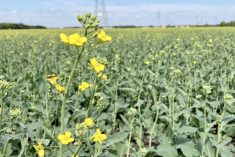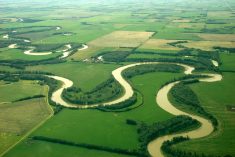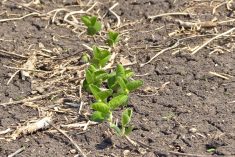[UPDATED: June 22, 2021] MarketsFarm — Western Canada’s canola crop has been hit hard by hot, dry weather so far this growing season in the midst of ongoing drought conditions — which may also be aiding another threat.
*Across the Prairies, flea beetles are an oft-seen pest that feeds on both canola and mustard seedlings, damaging crops and, in some cases, forcing growers to re-seed.
There are two main species: the striped flea beetle which thrives in cooler, wetter conditions, and the crucifer flea beetle which enjoys warm and dry weather. Adult populations are also known to feed on crops in late summer and early fall, but damage past the four-leaf stage is not considered as serious.
Read Also

Alberta crop conditions improve: report
Varied precipitation and warm temperatures were generally beneficial for crop development across Alberta during the week ended July 8, according to the latest provincial crop report released July 11.
“A percentage of the acres in Western Canada have flea beetle pressure, enough that causes concern. If you’re in an area that has high populations and you also have poor growing conditions or something else is wrong with your crop, flea beetles really become a management challenge,” Keith Gabert, agronomy specialist for the Canola Council of Canada, said.
Current hot spots for flea beetles, he said, are in north-central and east-central Saskatchewan as well as southern Manitoba. However, it’s difficult to predict where they may appear.
“It’s simply a numbers game,” he added. “If you have far too many flea beetles for the number of plants you’re trying to offer them or the leaf material that’s there, then the amount of damage that they do is pretty substantial.”
Temperatures between 17 and 25 C are when flea beetles can do the most damage. Anything else, they will move closer to the soil and underneath plants, according to Gabert.
In Saskatchewan and Alberta, flea beetles are prevalent in some areas. Near Regina, the crucifer type — a rarity in those parts — has been spotted. Northeastern Alberta has also been identified as a hot spot.
Growers are urged to scout fields for damage and to keep track of leaf area loss. Insecticides can be used in-crop once numbers pass the economic threshold.
“Folks need to start doing a little scouting, especially in the fall when the adults emerge before overwintering, to see what those numbers look like. That may give some perspective as to what’s coming in the spring,” Alberta’s acting provincial entomologist Doug MacAulay said.
— Adam Peleshaty reports for MarketsFarm from Stonewall, Man.
*Update: An earlier version of this story said flea beetle larvae feed on canola and mustard seedings. In fact it’s adult flea beetles.















